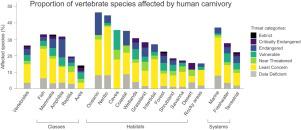Perspectives in Ecology and Conservation ( IF 4.7 ) Pub Date : 2020-11-02 , DOI: 10.1016/j.pecon.2020.10.002 Zulmira H. Coimbra , Luiz Gomes-Jr , Fernando A.S. Fernandez

|
Although a considerable part of the anthropogenic impacts on other species has been caused by our habit of eating other animals, little attention has been given to understanding and quantifying how human carnivory threatens biodiversity globally. Herein we review the anthropogenic threats to 1000 species randomly selected among more than 46,000 vertebrate entries in the IUCN Red List database. We identified the following mechanisms by which human carnivory (i.e., our habit of feeding on other animals and related products) negatively affects the world's vertebrates: two mechanisms related to predation (predation and bycatch), two to competition (prey depletion and persecution), one to biohazards (any negative impacts caused by livestock or alien species whose introduction is linked to human carnivory), four to environmental changes (destructive harvesting practices, livestock, agriculture, and climate change), and a miscellaneous category for processes more indirectly connected with our high trophic position. Our conservative estimate, which does not include livestock impacts via agriculture and climate change, reveals that about one-quarter of the world's vertebrates are threatened by at least one mechanism related to human carnivory, and that this proportion is higher than that attributable to other leading causes of biodiversity decline including agriculture, forestry, infrastructure, pollution, invasive species, energy production and mining, fire regime and water systems modifications, and climate change. Our results suggest that human carnivory is the major driver of the current biodiversity crisis, and we hope our findings may contribute to raise awareness about this fundamental yet overlooked aspect of human ecology.
中文翻译:

人类食肉动物是脊椎动物灭绝的主要驱动力
尽管对人类其他物种的很大一部分人为影响是由于我们的饮食习惯而造成的,但很少有人关注和量化人类食肉动物如何威胁全球生物多样性。本文中,我们回顾了IUCN红色名录数据库中超过46,000个脊椎动物条目中随机选择的1000种物种的人为威胁。我们确定了以下食肉动物(即我们以其他动物和相关产品为食的习惯)对世界脊椎动物造成负面影响的机制:与捕食有关的两种机制(捕食和兼捕),与竞争有关的两种机制(猎物的消耗和迫害),一种是生物危害(由与人类食肉动物有关的牲畜或外来物种造成的任何负面影响),第四项涉及环境变化(破坏性的收割方式,牲畜,农业和气候变化),而其他类别的过程则与我们的高营养地位更为间接地联系在一起。我们的保守估计(不包括农业和气候变化对牲畜的影响)显示,世界上约有四分之一的脊椎动物受到至少一种与人类食肉动物有关的机制的威胁,而且这一比例高于其他主要食肉动物的比例。生物多样性下降的原因包括农业,林业,基础设施,污染,入侵物种,能源生产和采矿,火灾状况和水系统改造以及气候变化。我们的结果表明,人类食肉是当前生物多样性危机的主要驱动力,


























 京公网安备 11010802027423号
京公网安备 11010802027423号